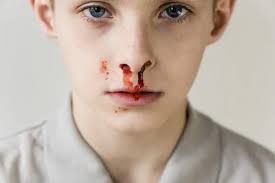Bending down, carrying heavy objects, or engaging in other strenuous tasks can create a nosebleed. In the 24 to 48 hours following the nosebleed, try to keep your activity light.
4. Apply an ice pack
Applying an ice pack wrapped in a cloth to your nose can assist to constrict blood vessels. It can also alleviate inflammation if you've had an injury.
To avoid harming your skin, don't leave the ice pack on for longer than 10 minutes at a time.
Our Other Must-Read Articles:
Questions people ask about Nosebleeds:
Q. Are nosebleeds in children serious?
A. Nosebleeds are usually not indicative of anything dangerous. They're widespread, particularly in children, and most can be easily treated at home.
Q. What can a nosebleed be a symbol of?
A. Nosebleeds are rarely fatal. Frequent or heavy nosebleeds, on the other hand, may suggest more serious health issues, such as high blood pressure or a blood clotting disorder, and should be investigated.
Excessive bleeding over a lengthy period of time might also result in complications such as anemia.
Q. Are nosebleeds symptoms of leukemia?
A. Patients with acute promyelocytic leukemia (APL), a form of AML, may experience bleeding and blood clotting issues.
They could have a nosebleed that won't go away or an oozing wound.
Q. What causes nosebleeds in females?
A. The most prevalent cause of nosebleeds is dry air. Hot, low-humidity climates or warm interior air can both contribute to dry air.
Both settings cause the nasal membrane (the fragile tissue inside your nose) to dry out and become crusty or cracked and more likely to bleed when rubbed or plucked or when blowing your nose.
Q. When should you be alarmed about nosebleeds?
A. If you can't stop the bleeding after 10 minutes or you are concerned about other facial injuries, consult a medical professional straight once.
Although nosebleeds are rarely a cause of concern, recurrent nosebleeds may suggest a more serious problem.
If you experience nosebleeds more than once a week, consult your doctor.
Q. Can nosebleeds happen for no reason?
A. The majority of nosebleeds are spontaneous, which means they occur without warning and without a known reason.
However, if you frequently experience nosebleeds, there may be a known cause. Dry environments or hot, dry air that dries out your nose's interior.
Q. Can dehydration cause nosebleeds?
A. Yes, dehydration may cause nosebleeds.
Q. What not to do after a nosebleed?
A. After a nosebleed, avoid blowing or picking your nose for many hours, as well as bending over.
Q. Can Iron deficiency cause nosebleeds?
A. On the contrary, Iron deficiency may be caused by excessive and frequent nosebleeds.
Q. What foods are good for nosebleeds?
A. Vitamin K and C-rich foods are beneficial for nosebleeds.
Foods high in vitamin K, such as kale, spinach, mustard greens, broccoli, cabbage, and others, are involved in the production of collagen, which contributes to the development of a moist lining within the nose. Orange, lemon and other citrus, foods contain vitamin C.
By keeping the blood arteries healthy, these vitamins help keep them from quickly rupturing.
Q. Is it OK to sleep after a nosebleed?
A. You can safely lie down and sleep once the blood has definitively stopped flowing and after some time has elapsed.
Of course, get medical attention if the nosebleed was caused by trauma or if there are any other symptoms.
Q. Are nosebleeds a symbol of diabetes?
A. Although nosebleeds are not a sign of diabetes, if you have the disease, you may be taking medication that makes them possible.
Diabetes medication metformin might result in bleeding. Metformin-induced nosebleeds are more likely to happen if you are taking a high dose but are not usually dangerous.
Q. Do bananas help in nosebleeds?
A. A person can consume bananas, avocados, tomatoes, or potassium supplements.
Vitamin C in these fruits is crucial in lowering the possibility of nosebleeds. Epistaxis blood vessels, as well as other blood vessels, benefit greatly from vitamin C.
__________________________
Friends, if you liked it, please share it with your friends.
SHARING IS CARING.
Compiled by: Paramjit Singh Rana


Comments
Post a Comment